Daniel Mazur and the redemption of Mt. Everest
Daniel Mazur and the redemption of Mt. Everest

Outhouse on Khumbu glacier
"It's all bullshit on Everest these days."
Sir Edmund Hillary's scathing judgment came in response to the appalling circumstances around the last hours of British climber David Sharp in May 2006, unassisted by dozens of other determined climbers who stepped over him as he lay dying just below the summit of Mt. Everest.
But Hillary might just as easily have been referring to the traffic jams of marginally competent climbers jumarred to fixed ropes or short-leashed to Sherpas, or the depleted juniper cover, or the desecration of sacred norms, or the unburied corpses, the campsites littered with expedition garbage, and, most alarming, the tons of excrement poised to slide into the glacial streams that supply water to downstream communities. Not bullshit, but human waste.

Garbage at Gorak Shep

Everest basecamp with lots of tents
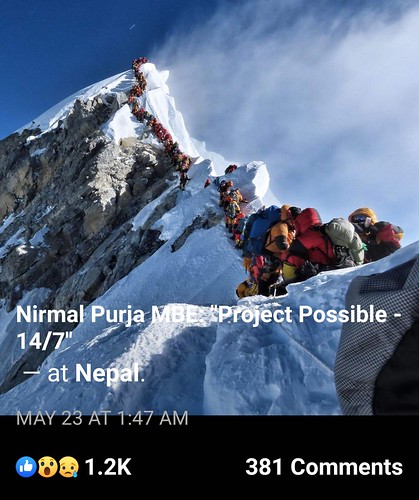
In the footsteps -- but not the spirit -- of Sir Edmund, hundreds of climbers become their own greatest obstacle.
May 2019 photo: Nirmal Purja/Project Possible
The Hillary Model of Development Assistance
For those of us who who are so invested in this most vulnerable of the world's last best places, the situation is dire—but not hopeless. Sir John Hunt's 1953 expedition, including team members Ed Hillary and Tenzing Norgay, contributed directly and indirectly to the damage, but Hillary also introduced a paradigm shift in development assistance that continues to mitigate some of that damage. Starting in 1960, he undertook a remarkable series of projects in response to and with the participation of local communities: 30 schools, 3 airstrips, 2 hospitals, uncounted water supply systems and bridges, reforestation initiatives, smallpox inoculation, educational scholarships, and on and on.
The prospects for Sherpa communities and their natural environment were radically improved, not by one single hero, but by the friends and strangers who collaborated with Sir Edmund and went on to undertake their own projects. The great triumph of the Hillary Model is that it went viral, a contagion that left us with an enduring alternative to the self-interested poison-pill variety of "foreign aid" that had prevailed for millennia of top-down imperial, colonial, mercantile, and religious programs.

Camp light at Everest
The Hillary Medal: celebrating lives well-lived
In 2003, with the personal authorization of Sir Edmund, Dr. Teiji Watanabe (Hokkaido University), Empar Alos (Valencia Polytechnic), and I initiated a new international award. The Sir Edmund Hillary Mountain Legacy Medal was intended both to honor its namesake and also to encourage the emulation of the Hillary Model of development assistance.
The mission is to recognize remarkable service in the conservation of culture and nature in mountainous regions, but most particularly, we aim to honor those who segue from adventures in mountain recreation to adventures in mountain development.
This past December, the recipient of our tenth medal was Dr. Daniel Mazur, an adventurer and philanthropist very much in the mold of Sir Edmund. Mazur also happens to be the man credited with the rescue of Lincoln Hall just weeks after the David Sharp debacle.
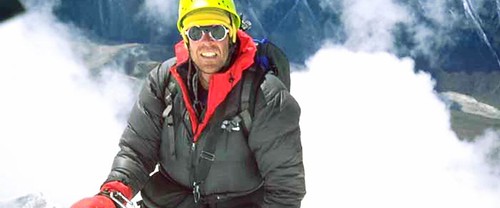
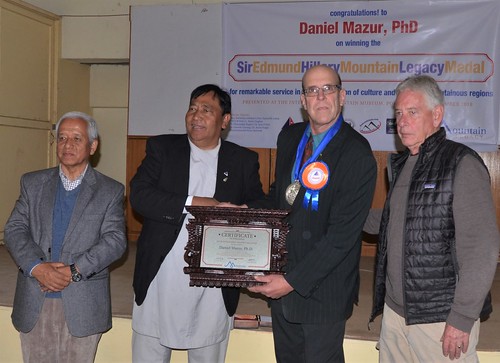
Dr. Ganesh Gurung, special advisor to the President of Nepal; Santa Bir Lama, president of the Nepal Mountaineering Association (NMA); Daniel Mazur; and Scott MacLennan, Founder and Executive Director of The Mountain Fund, and recipient of the Hillary Medal in 2010. The Nepal Mountaineering Association hosts the presentation of the Sir Edmund Hillary Mountain Legacy Medal on December 12 (the UN-designated International Mountain Day) at their International Mountain Museum in Pokhara; the presentation is a featured event in their annual Mountain Festival, which will be the subject of an upcoming article in Wandering Educators.

GR Pant, CEO of Nepal Mountaineering Association, and Dan Mazur at the Hillary Medal presentation

We don’t generally hand out Hillary Medals for feats of recreation, or physical heroism, but the rescue of Lincoln Hall is worth recounting, not least of all because it helped mitigate the damage done to Everest tourism by the terrible press following Sharp's death.
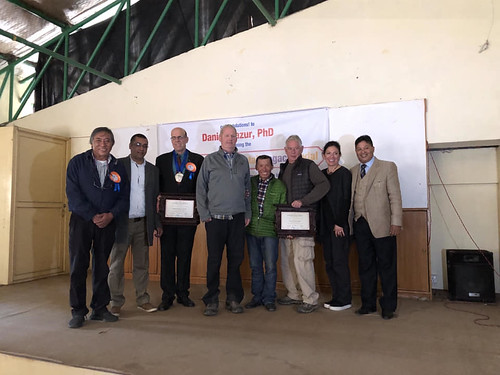
Lincoln Hall was a prominent Australian climber, a member of the first Aussie Everest expedition (1986), and a founding member of the Australian Himalayan Foundation, which is one of several non-profits established to follow in the footsteps of Hillary’s own Himalayan Trust. On May 25, 2006, Hall successfully summited Mt. Everest at 9am, along with three Sherpas. An hour later, descending in apparently fine form, Hall became confused: cerebral edema. Following a 17-hour rescue effort, the Sherpas radioed to basecamp from Mushroom Rock (8600m) just below the Second Step that Lincoln Hall was dead. Expedition leader Alexander Abramov ordered the guides, who were running out of oxygen, with snow blindness and edema setting in, to break off. They poked Hall in the eye to be sure he was gone, and left, taking his pack, sleeping bag, water, oxygen and food. It was 7:10pm.
Nevertheless, he persisted
Incredibly, Hall was found still alive the next morning, 12 hours later, by a different team making their own summit attempt. The group consisted of expedition leader Daniel Mazur, clients Andrew Brash and Myles Osborne, and lead guide Jangbu Sherpa. Osborne described the encounter:
“Sitting to our left, about two feet from a 10,000 foot drop, was a man. Not dead, not sleeping, but sitting cross legged, in the process of changing his shirt. He had his down suit unzipped to the waist, his arms out of the sleeves, was wearing no hat, no gloves, no sunglasses, had no oxygen mask, regulator, ice axe, oxygen, no sleeping bag, no mattress, no food nor water bottle. 'I imagine you're surprised to see me here,' he said. Now, this was a moment of total disbelief to us all. Here was a gentleman, apparently lucid, who had spent the night without oxygen at 8600m, without proper equipment and barely clothed. And ALIVE."

Lincoln Hall getting his shit together

Lincoln finds his glasses
Daniel Mazur and his team scuttled their summit attempt only 250 meters short of what was likely to be the chance of a lifetime for clients who had paid tens of thousands of dollars and risked their own lives. But they brought Lincoln Hall down, and he survived, minus a few finger tips. Reflecting on the issue in his Everest News report a couple of days later, Myles Osborne wrote,
“We must hold on to a basic value for human life that we all hold down at sea-level and keep that in the mountains. It's something that Summit Climb's Dan Mazur and other leaders involved in this rescue remember, but that many others sacrifice for the precious summit of this mountain.”
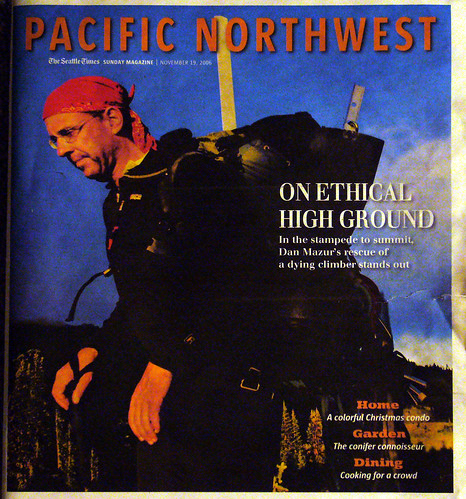
Mazur himself summed up the incident, “The summit is still there and we can go back. Lincoln only has one life."


Adventures in philanthropy
Through his non-profit NGO, the Mount Everest Foundation for Sustainable Development, Dan has undertaken numerous philanthropic projects. The one that I personally am most grateful for is the rehabilitation of the Deboche nunnery. The first time I trekked the Everest trail, back in 1975, I was dismayed at the conditions there. Located just below the world-famous Tengboche monastery, the convent was so miserable that I had to avert my eyes.

Deboche convent building before renovation
In 2004, philanthropist Marcia MacDonald was trekking with IME's Rick Wilcox to Everest Base Camp and at the same time looking for a spiritually resonant site in which to process the recent death of a relative. She was warmly welcomed by the anis (nuns) of Deboche convent, but she too was shocked by their suffering. There was no running water, electricity, or heating. The buildings were crumbling, uninsulated, with missing or broken window panes. The cooking stove was a couple of vegetable oil tins soldered together. Most of the women were wheezing and coughing from respiratory disorders, and there was no healthpost or medicine. Marcia promised she’d bring help.
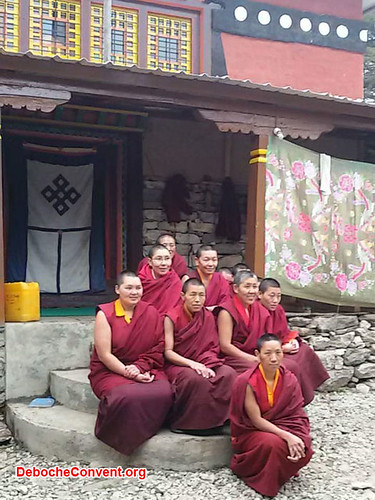
Deboche nuns in front of Deboche
Marcia MacDonald’s own mother asked, “Why do you want to do something on the other side of the world, when there are people suffering right here in America?” Marcia answered that suffering is global, and we need to teach our children to do whatever they can to help, and especially to support and emulate a culture that itself embodies pure compassion without constraints. Her mother became one of the Deboche Project’s most generous financial supporters.
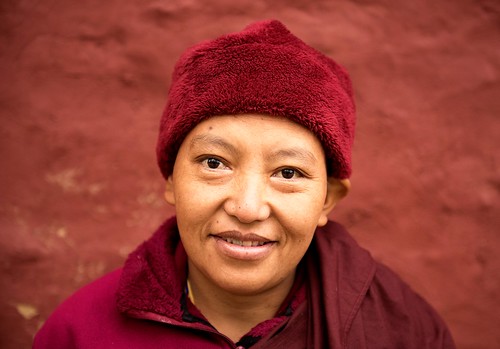
By 2006, Dan Mazur and Mingma Tenzing Sherpa had joined forces with MacDonald, and the Deboche Project was up and running. The initial phase entailed installation of a water line, two composting outhouses, two greenhouses, a proper kitchen stove, and three heating stoves. In addition, the buildings were renovated, with insulation, weatherproofing, and repaired walls, windows, and roofs. In all these efforts, Dan and his people have been attentive to local needs; a collateral result is that they were able to provide a convenient and reliable source of drinking water and fresh vegetables not only for the convent, but also for the neighboring community.
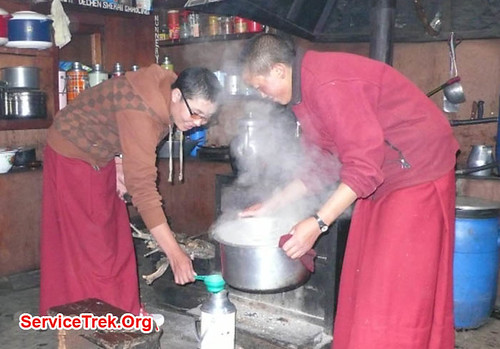
Cooking at Deboche

Porters carrying wood beams

Porter carrying wood for Deboche
The 2015 earthquakes dealt a severe blow to the convent, as to much of Nepal. However, with the pro-bono collaboration of the Seattle-based Architects Without Borders, spearheaded by Laura Rose, architect for REI among other notable clients, the Deboche buildings were rebuilt, implementing what the Project claims is a level of “eco-conscious design and seismic technology not seen previously in the Khumbu region.”

Earthquake at Deboche
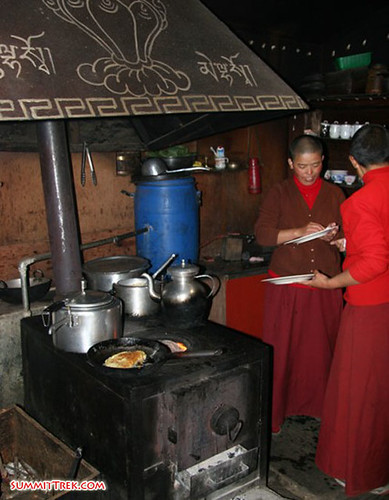
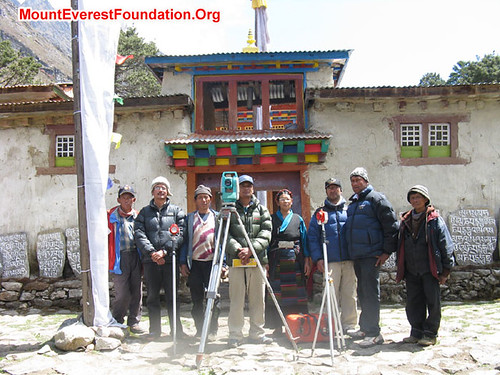

Deboche convent, almost finished
The mountain connection
More than most sports, mountaineering seems to be a natural jumping off point for do-goodery.
For one thing, the vertical dimension gives people a refreshed perspective on life.
Mundane goals seem less compelling when assessed in geological scales. The proximity of both triumph and death makes friendship more consequential. And, particularly in the more remote destinations, the disparate lifestyles and opportunities available to the host community members as contrasted with the transient adventurer, as well as the vulnerability of mountain landscapes and ecosystems, tend to impress visitors with what Martin Luther King referred to as “the fierce urgency of now.”
More specifically, there is a comprehensive overlap between the experience of leading an ambitious recreational mountain expedition and that of initiating a development assistance project in a remote destination. Both require great foresight and peripheral attention, minute planning, a high degree of competence in core skills, tolerance for extended periods of both drudgery and downtime, resilience in the face of adversity (and hostility from unexpected quarters), sangfroid in the contemplation of plausible failure as well as the imagination to envision new goals once current objectives are attained, and above all the ability to marshal resources and collaborators. Of course, the difficulty and expense of access is an intransigent cost multiplier.

Eminent montologist (and my own friend and mentor) Jack D. Ives took note of this conjunction in commending the selection of Daniel Mazur for last year’s Sir Edmund Hillary Mountain Legacy Medal:
"As we enter the centennial of Sir Edmund Hillary’s birth, it is fitting that we reflect on the importance of adventure in our lives.
Mountaineering should not be the province of the privileged few. Mountains evoke and educe our greatest values and aspirations: physical and psychological challenge, love of our environment, comradeship, and altruism. Daniel Mazur’s career perfectly synthesizes the challenges and opportunities of mountaineering and mountain service."

Marshalling resources and collaborators
Like Ed Hillary, Dan Mazur has been able to marshal an impressive array of resources, through a combination of tireless off-season speaking engagements and an variety of “service treks” in which individuals and groups pay for the privilege of participating in a worthy cause: delivery of medical supplies, disaster relief, cultural preservation, and so on. One of these treks was arranged for SalesForce, a cloud-based customer relationship management company that takes an exceptionally progressive attitude toward time off. In addition to standard vacation benefits (with certain imaginative wrinkles), SalesForce grants employees Volunteer Time Off (VTO) to work on philanthropic projects. A recent SalesForce VTO trek gave a significant boost to the Deboche Project, including corporate matching of donations from employees who participated in the trek.
In some cases, expedition clients are inspired to start their own projects, which are mentored by Dan and his Foundation. About five years ago, Wichita businessman Glenn Nyberg ran into trouble shortly after summiting Cho Oyo, the sixth highest peak in the world. Thanks to the extraction efforts of Dan and his team, Glenn survived...minus a lot of fingers and toes. As Glenn was recovering, he got news of the 2015 earthquakes, and soon returned to Nepal, both to thank his rescuers and to assess the damage. Jangbu, the lead Sherpa in his climb and in the evacuation, took Glenn to see the devastation in his home village of Patale. Since then Glenn and his wife Camille have been working on reconstruction projects for Patale, including a new school and health post. Meanwhile, Glenn was diagnosed with brain cancer, which has left him blind and infirm. But the work goes on. "It's not a situation where you can just build stuff and walk away," Nyberg observes.

Murari Sharma, Jangbu Sherpa, Glenn Nyberg, Daniel Mazur, Scott MacLennan, Sunita MacLennan
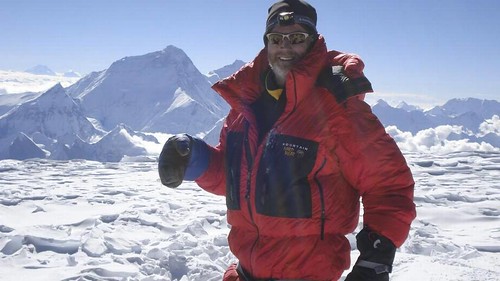
Glenn Nyberg
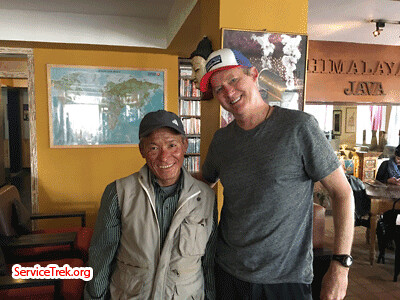
Glenn and Jangbu
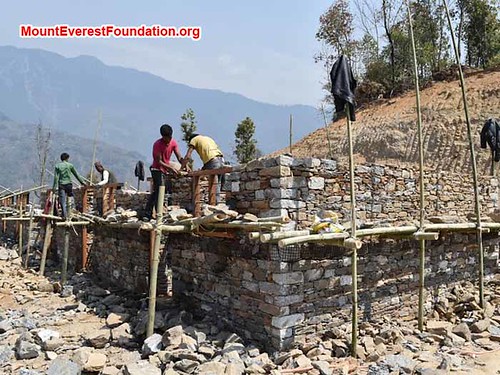
The school on March 11

New classroom in Patale

Medical help for Patale

Health Post

Patale health post crew
Some projects entail collaboration with other philanthropic non-profits. Dan has a long association with Scott and Sunita MacLennan of The Mountain Fund, serving as a member of the Board of Directors, and providing important support for a series of medical and educational installations. Most recently, Dan has been helping with the reconstruction and enhancement of Her Farm, a leadership and entrepreneurial training project that (notwithstanding its agricultural origins) trains women who have survived calamitous circumstances to compete for skilled careers in media, graphic design, and other more lucrative alternatives to the sort of subsistence that would have been their lot.
It's important to note that the Hillary Model of development assistance was never carried out exclusively by altruistic foreigners. Just as Hillary depended on Mingma Tsering, Ang Doule, Ang Rita, and other stalwarts, Dan Mazur has worked closely with Murari K. Sharma, Mingma Tenzin, and Jangbu Sherpa; in some cases it is Dan who is supporting their initiatives, not the other way around. (In fact, all three have been honored with nominations for the Hillary Medal.) And there are local residents, like Namche businessman Tsedam Sherpa. I met him in 1982, when he was a skinny teenager helping his mother run the family shop; I was doing research at Khumjung, the next village up from Namche, and I used to stop by every week for toilet paper, peanut butter, and Tibetan lessons. Now Tsedam is a wealthy entrepreneur, proprietor of International Mountain Equipment and also the palatial Zamling Guest House in Namche, a technical adviser to the Deboche Project,and a philanthropist in his own right.
Human waste awaits your help
Most recently, Mazur has been working with a group that will be installing a biogas conversion facility at Gorak Shep, the last cluster of lodges before Everest Base Camp. The plant is designed to use solar energy to compost the fourteen tons of human excrement evacuated each April and May from Mount Everest and the other peaks around in the Khumbu cirque. Led by engineers Garry Porter of the Mount Everest Biogas Project, Dr. Bed Mani Dahal of Kathmandu University, and Dr. Mike Marsolek of Seattle University, the project will produce cooking-grade methane fuel as well as reduce the downstream pollution that contributes to the gastro-intestinal problems that harm local people and dampen the enthusiasm of tourists.

Carrying off climber waste from mountain camp to dump somewhere else
As always, there are complications due to the altitude and remoteness of the processing site. Saving the last great places is not as expensive as the efforts that trashed them, but the costs are non-negligible.
As Jack Ives noted, this year is the centenary of Sir Edmund Hillary's birthday: he was born on July 20, 1919, and we have an idea for a suitable birthday present. The only bottleneck for the biogas project now is money. If every mountain climber and trekker visiting Nepal contributed a dollar, Dan and his collaborators could dispose of this grotesque issue.

Mt Everest biogas project as projected
It's not bullshit. It's ours, and we can get rid of it.
Happy birthday, Ed!

---------------------------
For more information, or to make a contribution, contact the Mount Everest Foundation for Sustainable Development: https://www.summitclimb.com/charity/MEFSD/ or dan [at] summitclimb.com
Seth Sicroff is the Nepal Editor for Wandering Educators, and Owner, Sunrise Pashmina



















